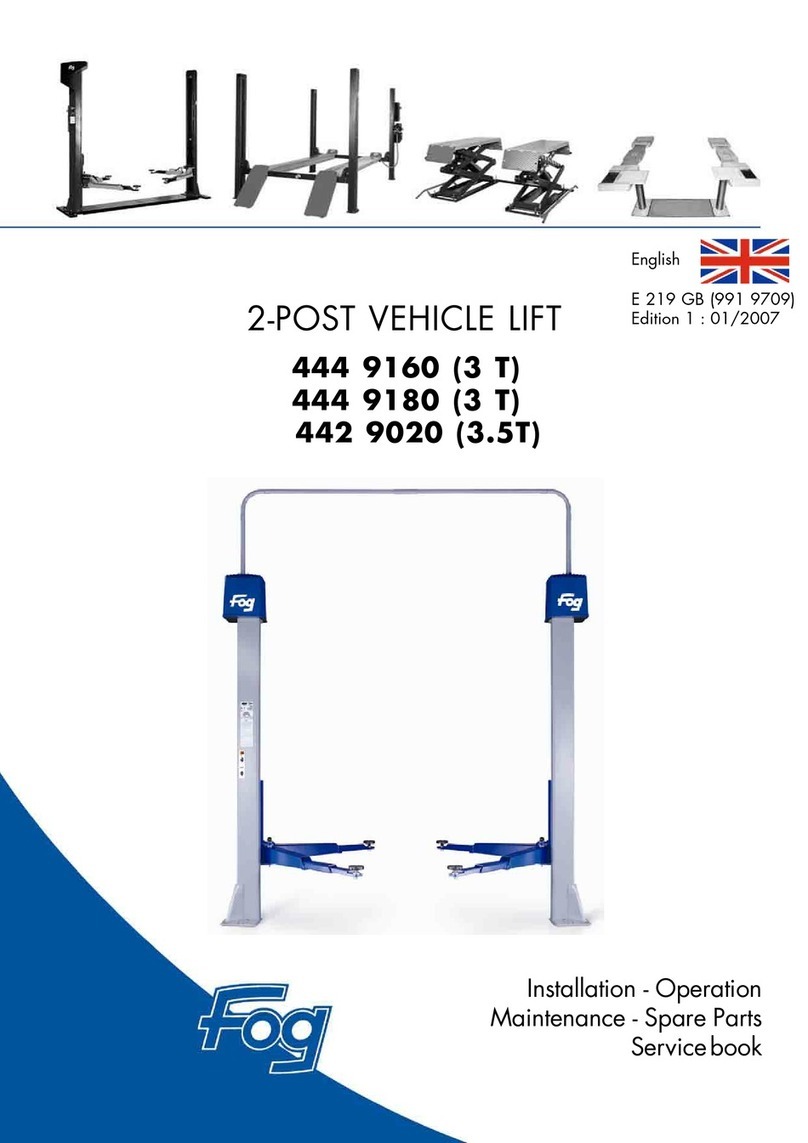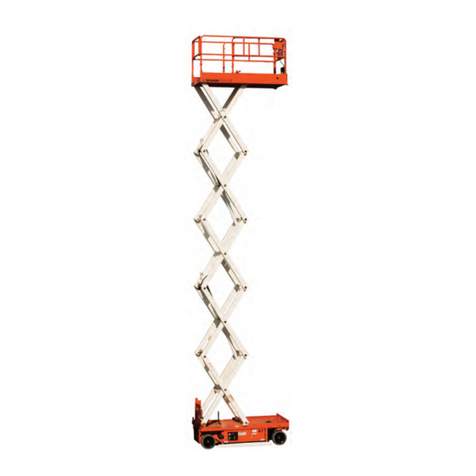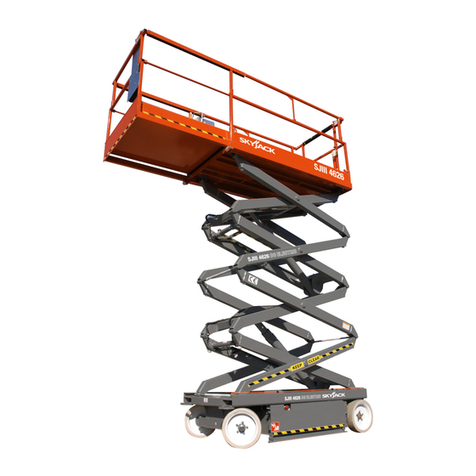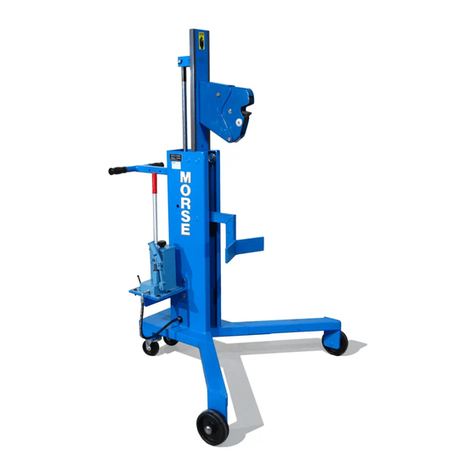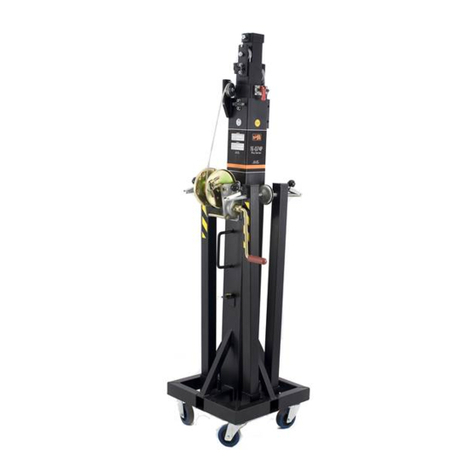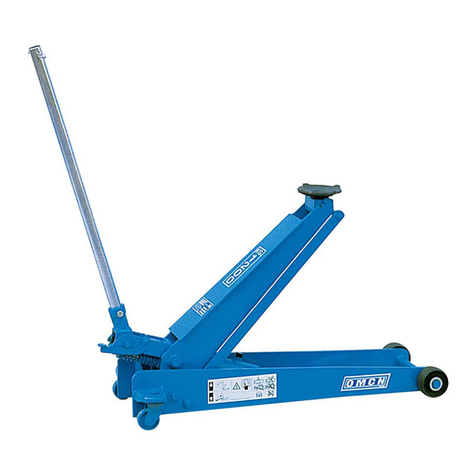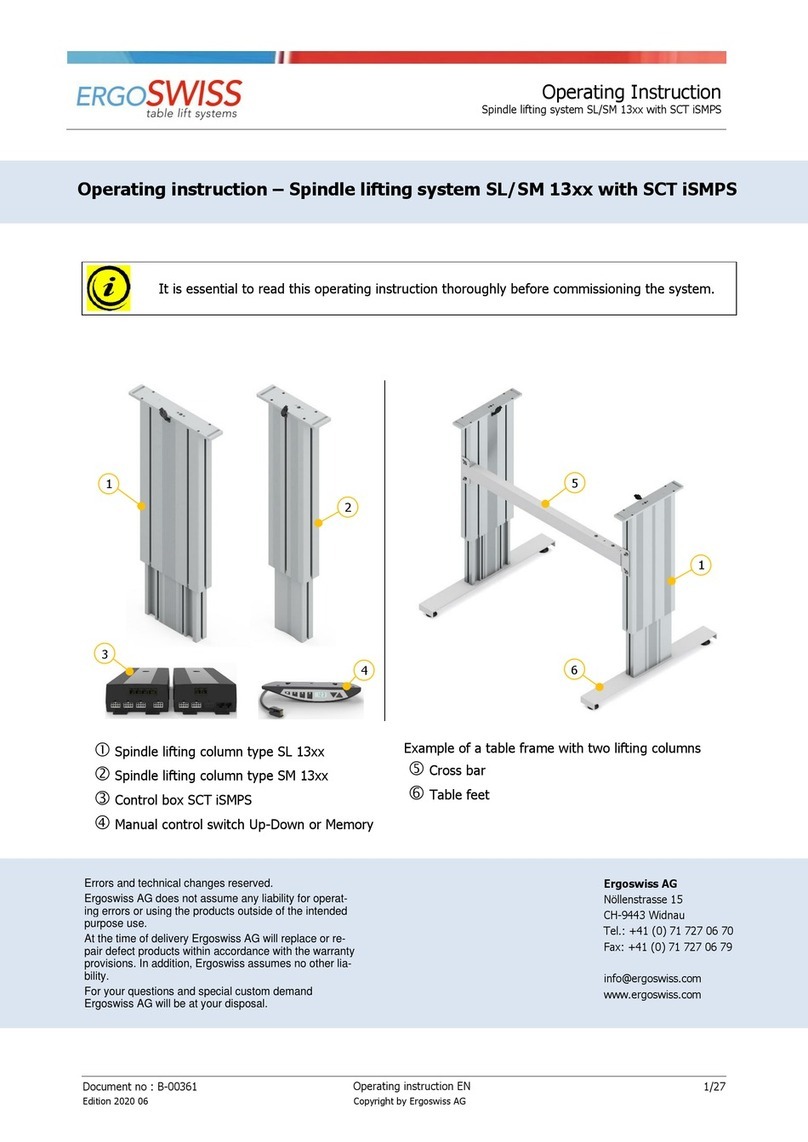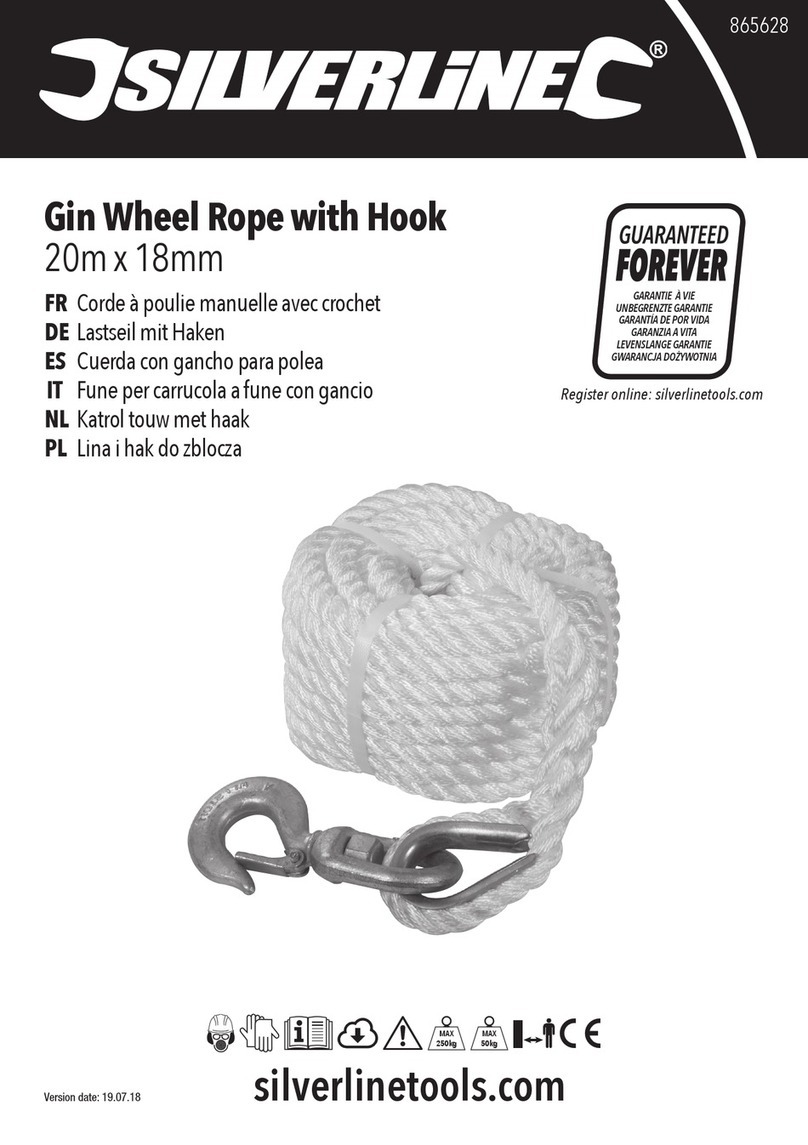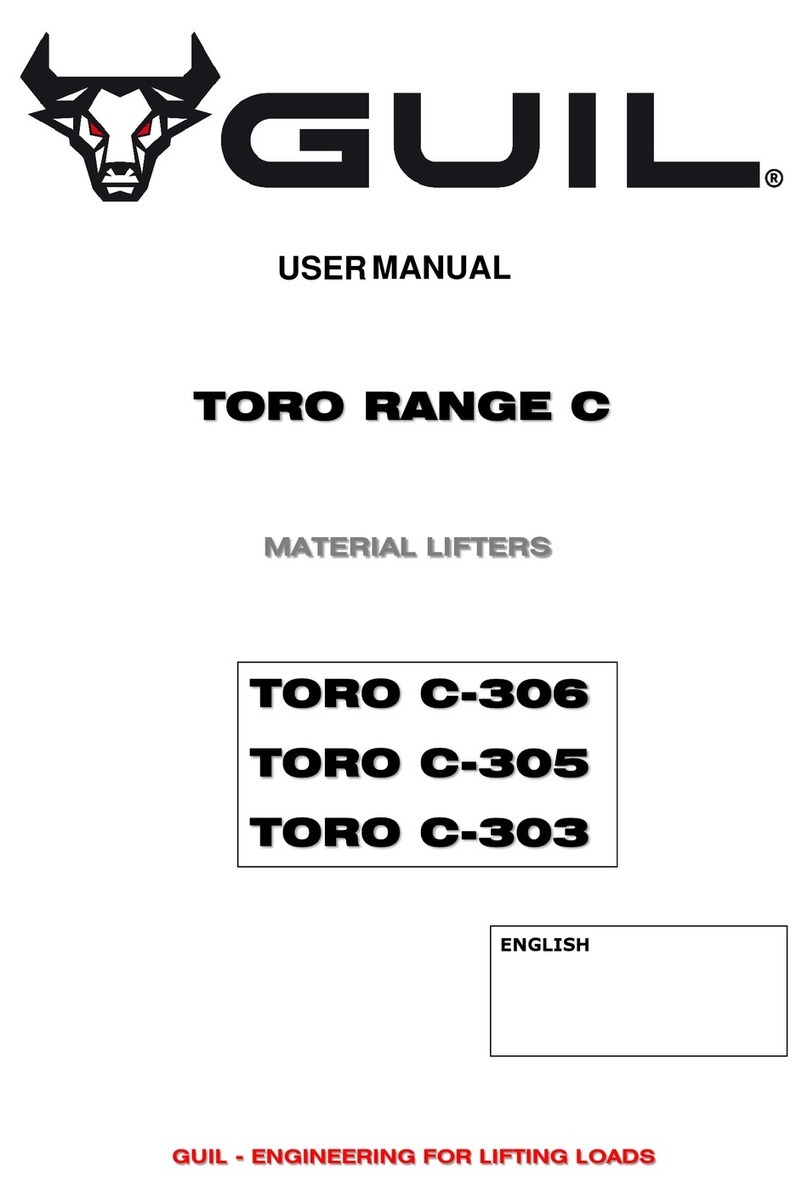FOG QUADRA 493 9021 Owner's manual

QUADRA
493 9021
493 9023
493 9031
VEHICLE LIFT
4 COLUMNS 3,5 TONNE
(AUXILIARY LIFT 3 TONNE)
Installation
Operation
Maintenance
E 167 GB
ISSUE 6 : 02/2003
English

E 167 - GB - 6 2Rue du Pré Neuf - 58440 MYENNES FRANCE
QUADRA
493 9021
493 9031
CONTENTS
HEALTH AND SAFETY PRECAUTIONS ............................................................................................................... 3
WARNINGS, CAUTIONS AND NOTES ............................................................................................................. 3
INSTALLATION ................................................................................................................................................ 6
Location and layout, Floor Specification
ASSEMBLING THE SUPERSTRUCTURE ............................................................................................................... 8
Identification of main components
Preparing the cross member
Component position
Platform level adjustment
Column adjustment
Motor column assembly
Fitting the wire ropes
Fitting the ladder racks
Fitting the hydraulic hose and electrical connections
CONNECTING TO THE ELECTRICITY SUPPLY .................................................................................................. 15
COMMISSIONING THE PUMP ....................................................................................................................... 15
Fitting accessories
Adjusting the level of the platform
Adjusting the wire ropes
Fitting and adjusting the Tie rods
Checking the column adjustment
Checking the latches
Checking the rocker arm retaining system
Checking the safety brake cam
Checking the wire rope safety switches
Checking the adjustment of the wire rope safety switches
Checking the obstruction/wire rope failure sensor
Checking the ladder latching
Checking the ram safety valve
COMMISSIONING THE AUXILIARY LIFT .......................................................................................................... 21
OPERATION .................................................................................................................................................. 22
Positioning the vehicle, Raising the platform, Lowering the platform
RAISING & LOWERING THE AUXILIARY PLATFORMS (493 9031) ...................................................................... 23
“LOWER” CONTROL...................................................................................................................................... 23
Changing the position of the lever
RAM SAFETY VALVE ....................................................................................................................................... 24
Check and adjustments, Thread torque
LOWER THE PLATFORM AND AUXILIARY WITHOUT ELECTRICAL POWER ......................................................... 24
MAINTENANCE ............................................................................................................................................ 26
General, Monthly, Annual lift test
OVERLOAD TESTS .......................................................................................................................................... 27
FAULT FINDING ............................................................................................................................................ 28
TECHNICAL SPECIFICATION .......................................................................................................................... 36
ADD-ON FOR 493 9021 ................................................................................................................................. 37
ADD-ON FOR 493 9031 ................................................................................................................................. 44
SPECIFICITY OF SINGLE PHASE WIRING DIAGRAM ........................................................................................ 55
PROCEDURE ADJUSTMENT OF THE FLOW CONTROL VALVE (POWER UNIT HPI) ............................................... 56
WARRANTY RETURN FORM .......................................................................................................... 57
DECLARATION OF CONFORMITY .................................................................................................................. 59

QUADRA
3 E 167 - GB - 6
Rue du Pré Neuf - 58440 MYENNES FRANCE
493 9021
493 9031
I HEALTH AND SAFETY PRECAUTIONS
In order to comply with your responsibilities under the Health and Safety at Work Act 1974, it is essential
that the Quadra and any optional accessories are sited, installed, operated, and maintained by *competent
persons in accordance with the instructions in this manual.
* A competent person should be a minimum of 18 years of age and have a minimum
qualification of NVQ 3 (or an equivalent qualification) and / or experience within their
own field of responsibility, e.g. installation engineering, automobile engineering etc.
It is important that all persons installing, operating or maintaining the Quadra and
optional accessories must also be familiar with the layout of the equipment, safety
precautions and vehicle lifting points. Appropriate training will be required,
prior
to
installing, using or maintaining the lift
WARNINGS, CAUTIONS AND NOTES
‘WARNING’ is used in the text of this manual to identify specific hazards which can cause injury or death.
‘CAUTION’ is used in the text of this manual to identify incorrect procedures which can cause damage to the
Quadra.
‘NOTE’ is used in the text of this manual to draw attention to specific points of importance.
WARNING SYMBOLS
WARNING
ELECTRICAL
DANGER
230V OR 400V
READ THIS
MANUAL
BEFORE USE
WARNING
OR
CAUTION

E 167 - GB - 6 4Rue du Pré Neuf - 58440 MYENNES FRANCE
QUADRA
493 9021
493 9031
CE IDENTIFICATION PLATE

QUADRA
5 E 167 - GB - 6
Rue du Pré Neuf - 58440 MYENNES FRANCE
493 9021
493 9031
Changes to this manual are as shown below. Revised or additional issues of this manual are available
from F.F.B. S.A. Rue du Pré Neuf 58440 MYENNES - FRANCE.
Minor changes are indicated by the use of a broad line adjacent to the affected text.
PUBLICATION ISSUE CHANGES TEXT AFFECTED
26/08/97 Artwork Layout
05/99 2 euro
12/01 3 Modifications of the references in all the doc.
493 9001 --> 493 9021; 493 9003 --> 493 9023
493 9011 --> 493 9031 + insertion of additives 493 9021
& 493 9031.
05/02 4 Specificity of single phase wiring diagram and Procedure
adjustment of the flow control valve added, CE identification
plate updated, modifications of Fig. 7 p.17, Fig. 19 p.27,
Fig. 19, 20 and 21 p.37, and suppression of the paragraph
“Re-fitting the lever” p. 42 and of the Fig. 20 p. 43.
07/02 5 Suppression of the paragraph “Checking the upper limit
switch” p. 34, some modifications p. 36 and more precise
wiring diagram p. 2 of the additive 493 9031.
02/03 6 Warranty return form now included and EC declaration of
conformity updated.
MODEL NO:
SERIAL NO:
DATE OF INSTALLATION: .............................................
DATE OF LOAD TESTS: .............................................
INSTALLED BY: .............................................

E 167 - GB - 6 6Rue du Pré Neuf - 58440 MYENNES FRANCE
QUADRA
493 9021
493 9031
INSTALLATION
Location and site layout
This lift should be installed so that:
•It is sheltered from the elements.
•There is sufficient headroom.
•The “motor column” that houses the power-pack, control box etc. is positioned at the rear
on the left-hand side.
•A three-phase power supply is available nearby (400 V, 1.85 kW). This must have fused
circuit protection. NOTE: With 400 V, a neutral conductor is not required to operate the
lift, but it will allow any accessories requiring a 230 V supply e.g. lighting to be fitted.
•The front or rear of the vehicle must not come into contact with walls, doors or any
other obstructions, and all minimum safety clearances must be observed (Fig. 1).
Floor Specification
With regard to the area on which the four column base plates are to be positioned :
•The floor must be on a common horizontal plane (within +/- 4mm) including that up to
2000mm in front of the cross-member(s) so that vehicles with restricted ground clearance
can drive onto the platform. A slight downward slope towards the front of the lift is
acceptable, provided that it is compensated for by placing shims under the columns.
•The pads must be constructed from C:30 concrete extending over a minimum area of
800 x 650 mm and at least 160mm thick, excluding the thickness of any screed or paving that
may be added. In the case of an existing floor, check its suitability with qualified person
e.g. structural engineer, architect etc.
Where the lift is to be installed on an upper storey, the floor should be able to withstand the stresses given
below. This should be checked by a qualified person e.g. structural engineer, architect etc.
493 9021 493 9031
Uniformly distributed loading 242 kg/m2266 kg/m2
Point loading 1.6 kg/cm21.8 kg/cm2
CAUTION: THE OVERLOAD FIGURES GIVEN ABOVE DO NOT TAKE INTO
ACCOUNT ANY DYNAMIC OR STATIC OVERLOAD TESTS OR THE PARKING
OF A VEHICLE UNDER A LOADED PLATFORM.
Fig. 1
4430
>800
Power
supply
> 1040 2784
>650 or 800
if access
required
ACCESS
800
>650 or 800
if access
required
Depending on
vehicule ( 950)
~

QUADRA
7 E 167 - GB - 6
Rue du Pré Neuf - 58440 MYENNES FRANCE
493 9021
493 9031
Electrical supply
Provision may be made for a conduit in the floor (minimum 20mm internal diameter) which exits either
outside the base plate or in the column through the 25mm diameter hole (Fig. 2).
Columns
The columns are secured to the concrete pads with the anchor bolts supplied.
CAUTION: IF THE FLOOR IS SCREEDED OR TILED, THE LENGTH OF THE
ANCHOR BOLTS SHOULD BE INCREASED PROPORTIONALLY - CUSTOMER
RESPONSIBILITY.
Floor Plan
Mark clearly around the outside contour of the column base plates. (See Fig. 2)
Fig. 2
(Theoretical)
Cross-member axis
Elongated
hole

E 167 - GB - 6 8Rue du Pré Neuf - 58440 MYENNES FRANCE
QUADRA
493 9021
493 9031
ASSEMBLING THE SUPERSTRUCTURE
Identification of the main components
Unpack the component parts and identify them in accordance with Fig. 3.
The motor column (4) has several holes on its main face as well as the identification and instruction plates.
Columns 1, 2 and 3 are all similar, but the one that has a large vertical ‘Fog’ logo must be positioned on
the ‘drive on’ side on the left.
Preparing the cross members
Position the junction boxes correctly according to the type of lift (see Fig.4):
•in holes (A) for lift 493 9021
•in holes (B) for lift 493 9031
Fig. 3
COLUMN 1
COLUMN 4
(motor)
COLUMN 3 COLUMN 2
Junction
box
Junction
box
Wheel-guides
ADJUSTABLE
TRACK
CROSS-MEMBER 3 - 4
FIXED
TRACK
CROSS-MEMBER 1 - 2
Horizontal gusset
with single pulley Horizontal gusset
with single pulley
Fig. 4

QUADRA
9 E 167 - GB - 6
Rue du Pré Neuf - 58440 MYENNES FRANCE
493 9021
493 9031
Component position
Position on the floor plan all of the components that make up the lift, in the following order:
•Cross-members: Place a suitable support under the cross-members, and under the horizontal gusset.
•Columns: Engage the columns as far as possible onto the vertical cheek-plates of the cross
members and position them correctly on the floor, move the cross-members if necessary.
•Fixed track: Place the fixed track on the cross-member horizontal gussets, with its wheel guide
flange facing inwards. Locate the connecting screws (Fig. 5) but do not tighten them. Pay
attention to the position of the wire rope guide screws.
•Adjustable track: Place the adjustable track on the cross-members as far as possible from the
fixed track and with its wheel guide flange facing inwards. Move the ends of the cross-
members so the track can fit in-between them in order to give 2 to 3 mm clearance between
the cross-member beam and the bosses at each end (Fig. 6). Tighten the connecting screws to
secure the horizontal gusset onto the fixed track.
Platform level adjustment
Adjusting the amount of shims under the cross-members. To ensure that the platform is level. This can be
verified as follows:
•laterally, using a spirit-level on the cross-members.
•longitudinally, using a spirit-level in the centre of the track.
Column adjustment
Measure and compare the distances between the column base plates and the ends of the cross-members.
A difference of 15 mm can be accommodated by adjusting the ladder rack in the column. If the difference
is greater than this, the lowest column(s) should be raised by placing shims under the base plate(s) or by
using the lifting screws.
Maintain the position of the base plate on the floor plan, then check each column in succession as follows:
•Whether it is vertical, using a plumb-line. If not, place shims under the base plate or adjust the
lifting screws.
•Whether it is square, using a rule placed on the main inside face of the column and sighting
the column opposite.
•Whether there is clearance of 1mm between the roller on the end of the cross-member and
the inside of the column (Fig. 14).

E 167 - GB - 6 10 Rue du Pré Neuf - 58440 MYENNES FRANCE
QUADRA
493 9021
493 9031
Fig. 5
SCREW M12 X 20
TOP CABLE
GUIDE
BOTTOM CABLE
GUIDE
Fig. 6
Clearance: 2 to 3 mm
CROSS-MEMBER BOSS
ADJUSTABLE
TRACK
NUT M 20
LADDER RACK
ROLLER
Approx. 1 mm clearance
(only with cross-member in
bottom position)
Fig. 14

QUADRA
11 E 167 - GB - 6
Rue du Pré Neuf - 58440 MYENNES FRANCE
493 9021
493 9031
Anchoring the columns
Drill the holes for the anchor bolts using the base plates as templates. Ensure that the columns are as vertical
as possible and concentric in relation to the base plate holes in order to allow column adjustment. If drilling
cannot be completed with the column in place, trace the position of the holes on the floor as accurately as
possible, remove the column and its shims, noting their positions.
Fit a large washer in position under the bolt head, locate the anchor bolts in position and tighten them.
Before anchoring the motor column, ensure all the necessary parts are fitted. Check the column adjustments
(verticality, squareness and 1mm clearance), alter the shims if necessary.
Motor column assembly
While it is more convenient to assemble the motor column when it is positioned at bench height, it is also
possible to do this with the column in an upright position, secured to the ground (See Fig. 7).
CAUTION: THE MOTOR COLUMN ASSEMBLY WILL NOT STAND UPRIGHT BY
ITSELF. THE RESERVOIR FOR THE MOTOR PUMP UNIT IS MADE OF PLASTIC.
•Attach the control panel mounting plate using four TH M8 x 16 screws and serrated lock washers.
•Attach the power-pack using four TH 8 x 16 screws and serrated lock washers between the 'U' bracket
and the column and four M8 x 20 screws, serrated lock washers and M8 nuts between the motor and
the 'U' brackets).
•Position the motor coupling links as appropriate and connect the cable, route it to the left of the motor.
• Attach the upper limit switch to its bracket using two C M4 x 25 screws and serrated lock washers.
Fit the bracket to the top of column on the inside with two TH M6 x 10 screws and serrated lock washers.
• Feed the cable through the column and connect it onto the control panel.
Fitting the wire ropes
•Bring the platform to rest on the latches at about 1000 mm from the floor, by alternately raising each
cross-member 2 or 3 slots, using a crane, jack or a lever engaged in one slot of the ladder rack and a
wooden block inserted between the lever and the bottom of the vertical cheek plate.
•At each end of the fixed track, remove the wire rope guide screws (Fig. 4).
•Unwind the wire ropes over a clean floor, they have a steel core and must not be subjected to any
kinking or bending during their installation. The ends of the wire ropes are colour-coded and should
be threaded over pulley grooves of the same colour as the rope.
Insert the following into the rectangular aperture on the cross-member beam 1-2:
•The loop of the white and yellow wire ropes to the left of the twin pulleys and then route it over the
crossbar, so that the yellow wire rope (the shortest) is uppermost.
•The end of the white wire rope to the right of the twin pulleys and then bring it along the track and out
through the rectangular aperture in the side of the cross-member 3-4.
•The loop of the red and blue wire ropes to the right of the twin pulleys and then route it over the crossbar
so that the red wire rope (the shortest) is uppermost.
•The end of the blue wire rope to the left of the twin pulleys and then in a similar way as the white wire
rope and out through the other end of the track.
•Attach the nylon roller by its shoulder screw onto the end of the crossbar, on the side of the red and blue
wire ropes (inner side of the platform).
•Remove the vertical pulleys from cross-member 1-2 and then feed the end of the red and yellow wire
ropes in through the beam until they reach their respective columns. Ensure that the wire ropes are
correctly positioned in the grooves of the twin pulleys and replace the three wire rope guide screws.

E 167 - GB - 6 12 Rue du Pré Neuf - 58440 MYENNES FRANCE
QUADRA
493 9021
493 9031
At each end of the cross-member, feed the wire rope under the sensing roller which should always be kept
in the upper position, then insert it into the groove of the vertical pulley and then insert the end of each wire
rope through the top of the column, fit the shoulder collar and the two nuts.
In a similar way, route the white and blue wire ropes in cross-member 3-4 and fit them to their respective
columns.
Fig. 7
Fig. 4

QUADRA
13 E 167 - GB - 6
Rue du Pré Neuf - 58440 MYENNES FRANCE
493 9021
493 9031
Fitting the ladder racks
CAUTION: UNDER NO CIRCUMSTANCES SHOULD THE LADDER RACKS BE
PAINTED. IF NECESSARY, CLEAN THEM, SCRAPE OFF ANY EXCESS RUST
AND THEN COAT WITH THICK OIL.
The top of the platform must not be more than 300mm from the ground, when fitting the ladder racks.
On each column:
•Raise the wire rope sensing roller and retain in elevated position.
•Insert the ladder rack into the vertical cheek plate of the cross-member.
•Insert a stud bolt into the top of the column, screw a M16 locknut onto its lowest end, before
screwing it fully into the ladder rack. Then lock the nut into position.
•Fit the shoulder screw through the ladder rack then into the threaded hole at the base of the
column.
•Screw an M16 nut onto the top end of the bolt until the ladder rack no longer rests on the
shoulder screw at the bottom of the column, then add an M16 locknut.
Fitting the hydraulic hose and electrical connections - 493 9021
•Connect the high pressure hose onto the ram, forming a large loop around the horizontal
pulleys.
•Connect the oil return hose onto the ram.
•Bring the coiled electrical cable into the cross-member.
•Fit the conduit entry fittings at each end and fit them onto their respective brackets.
•Thread the two hoses and the electrical cable through the conduit.
•Attach the conduit support lug onto the track using two M8 x 16 screws with serrated lock
washers.
•Connect both the high pressure hoses and oil return hose onto the power-pack.
•Fix the conduit support lug onto the power-pack using a screw and serrated lock washer.
•Connect the electrical cable onto the mounting plate.
•Check that the circuit breaker has been set correctly as follows:
6.3 A in 400 V
10 A in 230 V
•Connect the two junction boxes mounted on the cross-members, using the designated cable.

E 167 - GB - 6 14 Rue du Pré Neuf - 58440 MYENNES FRANCE
QUADRA
493 9021
493 9031
Fitting the hydraulic hose and electrical connections - 493 9031
•Connect the high pressure hose onto the auxiliary lifting ram in the adjustable track. The oil
return hose must be attached as soon as the auxiliary unit is mounted in position.
•Route the hoses into the chain and secure the chain along the cross-member using two M6 x 16
screws with serrated washers. Fit the angle bracket using two M8 x 16 screws with serrated
lock washers.
•Fit the inversion valve angle bracket onto the track using three M8 x 16 screws with serrated
lock washers.
•Connect the conduit and glands onto these two angle brackets.
•Connect the electrical cables into the junction boxes on the cross-members.
•Connect the HP hoses according to Fig. 11.
•Thread the HP and oil return hoses together with the electrical cable into the conduit and
connect them onto the power-pack.
•Fit the conduit angle bracket onto the power-pack using one M8 x 16 screw with serrated lock
washers.
•Connect the electrical cables onto the control panel.
•Check the settings of the circuit breaker are as follows:
6.3 A for 400 V
10 A for 230 V
Fig. 11
LIFT 493 9021
LIFT 493 9031

QUADRA
15 E 167 - GB - 6
Rue du Pré Neuf - 58440 MYENNES FRANCE
493 9021
493 9031
CONNECTING TO THE ELECTRICITY SUPPLY
IMPORTANT: THE ELECTRICAL SUPPLY MUST CONFORM WITH THE
CURRENT EDITION OF THE IEE REGULATIONS.
The rating [SIZE] of the supply control fuses should be as follows:
- 230 V Three phase 10 A aM
- 400 V Three phase 6 A aM
The conductor section for the supply should be as follows:
VOLTAGE LENGTH OF LINE CONDUCTOR CROSS-SECTION
400 V less than 100 m 1.5 mm2
100 to 150 m 2.5 mm2
230 V less than 35 m 1.5 mm2
35 to 55 m 2.5 mm2
•Check that the transformer voltage and the circuit breaker rating and its settings all correspond
to the voltage. Connect the electrical supply to the control panel.
•Check that the fuse-holder mounted on the terminal block carries the correct fuse.
•Check the direction of rotation of the motor: rotate the circuit breaker to position 1, then observe
the direction of rotation of the motor fan by briefly rotating the control knob towards RAISE.
If the fan does not turn in a clockwise direction, isolate the electrical supply. Interchange two of
the phases in the electrical supply and re-check.
COMMISSIONING THE PUMP
Fill the pump unit reservoir with the correct grade of oil as follows:
493 9021 8 litres of S.A.E.: 10W30, 10W40 oil or hydraulic oil Ref. 4939031
493 9031 8 litres of hydraulic oil - ONLY USE that supplied with the lift (Ref. 256 8011)
Engler viscosity at 20 C : 4 to 4.5
NOTE: An extra two litres of oil will be required after the rams have been bled.
Tension the wire ropes by turning the control knob towards 'RAISE', checking regularly that none of the wire
ropes have slipped out of the pulley grooves. Raise the platform by about 100mm and check the following:
•That none of the wire ropes are fouling a metal part or an electrical cable.
•That the latches retract simultaneously when the control knob is turned towards 'LOWER'.
•At each end of the cross-member, check that there is clearance of between the limit switch roller
and the rocker arm cam (Fig. 12).
Fig. 12
LOCKNUT
RETAINING ROD
ROLLER
SWITCH
ROCKER
Clearance: 0 to 0.5 mm
Clearance: 1.2 to 1.5 mm
CAM
LADDER RACK
LOCKNUT
RETAINING ROD
ROCKER
SWITCH
Clearance: 0 to 0.5 mm
CAM
LADDER RACK
ROLLER
Clearance:1.2 to1.5 mm

E 167 - GB - 6 16 Rue du Pré Neuf - 58440 MYENNES FRANCE
QUADRA
493 9021
493 9031
Fitting accessories
•Fit the blanking (inspection) plate to the end of each cross-member in the (fixed track) axis.
•Hang the access ramps onto the end of the tracks on the 'drive on' side, and then insert the
retaining rod into the hooks and locate and fit the split pins in position.
•Attach the end stops onto the tracks at the opposite end to the drive on direction. (Fig. 19).
•Fit the blanking plates onto the tracks.
Adjusting the level of the platform
Rest the platform on the latches at about 500mm from the ground and fully slacken the wire ropes by
operating the ‘LOWER’ lever for a short period, after the platform comes to a stop.
By adjusting the nuts on the ladder suspension stud bolts, check that the platform is level:
•laterally, using a spirit level on each of the cross-members
•longitudinally using a spirit level in the centre of a track
CAUTION: WHEN ADJUSTING THE NUTS ON THE LADDER SUSPENSION
BOLTS, CHECK THAT THE RETAINING SCREW ON THE LOWER END OF THE
LADDER RACK IS NOT CLAMPED IN ITS ELONGATED HOLE AND THAT THE
WIRE ROPE IS KEPT SLACK, IF NECESSARY, OPERATE THE ‘LOWER’ LEVER
FOR A MOMENT.
Adjusting the wire ropes
This adjustment is necessary in order to:
•prevent one or more of the wire rope safety switches from operating when the platform is in its
lowest position.
•allow the latches to be engaged simultaneously, by eliminating any stretch in the wire ropes
under load. NOTE: a long wire rope should be shortened more than a short one to
compensate for 'elastic' stretch.
CAUTION: WHEN ADJUSTING A WIRE ROPE NUT, ALWAYS HOLD THE END
OF THE WIRE ROPE FERRULE TO PREVENT THE ROPE TWISTING.
•Lower the platform to the ground. Release the button that unlocks the latches and then the
‘LOWER’ lever, after having pulled on the wire rope in column 4 (Fig. 13) so that the ram is
fully extended.
•Adjust each wire rope end in turn until a measurement of 62 +/- 2 mm is obtained between the
bottom of the cross-member cheek plate and the top of the column base plate. A clearance of
7 to 10 mm is to be obtained between the bottom of the cheek plate and the lower column stop
(1 turn of the nut = 2 mm).
•Position a vehicle weighing approx. 2,500 kg on the platform and raise it to eye level, leaving
it suspended on the wire ropes.
•Measure the dimension 'X' (See Fig. 13) for each column and identify the highest cross-member
end in relation to the ladder slots.
•Raise the other ends by turning the nut on the wire rope end fitting until they are brought
to the same level as the highest end (1 turn of the nut = 2 mm).
•Fit a and fully tighten locknut onto each wire rope.
•Fit the column covers in position.

QUADRA
17 E 167 - GB - 6
Rue du Pré Neuf - 58440 MYENNES FRANCE
493 9021
493 9031
Fitting and adjusting the tie rods
Raise the platform, without letting it rest on its latches. At each end of the fixed track:
•Insert the threaded rods into the tubes located in the track (Fig. 15).
•Screw two M12 nuts (a) and (b) onto the rod.
•Position an M12 nut in the cross-member cheek plate. Tighten the M12 nut (a) fully against
the bracket.
•Screw a M12 nut (c) onto the other end.
•Adjust nuts (b) and (c) until the flanges of the vertical cheek plate are parallel in the column
and tighten them fully.
Fig. 15
CHEEKPLATE FLANGE
PLASTIC STUD
TIE BOL
T
NUT M 12
THE BOLT
CHEEKPLATE FLANGE
NUT M 12
PLASTIC STUD
Fig. 19 Fig. 13
FIXED END-STOP
2 WAY VALVE
for levelling
SOLENOID
Emergency lowering
‘LOWER’ Lever
Cross member
vertical gusset
Ladder

E 167 - GB - 6 18 Rue du Pré Neuf - 58440 MYENNES FRANCE
QUADRA
493 9021
493 9031
Checking the column adjustment
Raise the unloaded platform to 300mm from the ground, suspended by the wire ropes.
Check the following:
•That each column is square, using a rule placed firmly on the outer surface, and which is then
used to sight the opposite column.
•That each column is centred on its cross-member cheek plate to prevent excessive friction on the
plastic studs on the column aperture.
•That the clearance between each cross-member and column is between 1 to 3 mm.
•That each column is vertical, by means of a plumb line. In order to eliminate any clearance
between cross-members when the platform is in its operating position, the distance between the
tops of the columns of one particular cross-member must be slightly less (5 to 15 mm).
NOTE: If a cross-member is too tight between columns, an unladen platform could jam when
being lowered, causing the wire rope to slacken and the latches to engage in the ladders.
If necessary, adjust the position or the vertical plane of one or more columns, by placing shims under the
base plate and adjusting one or more of the tie-rods under the ends of the fixed track.
Check inside the columns with the platform at three different heights e.g. low, medium, high, that the ladder
edges do not rub on the inner surfaces of the cheek plate flanges.
Checking the latches
With the platform raised and suspended on the wire ropes, check at each end of the cross-members that the
latch operates freely without sticking. If necessary, identify the cause of the problem and rectify (e.g. rust,
using too thick an oil to lubricate it, latching solenoid sticking due to ingress of dirt etc.)
Checking the rocker arm retaining system
With the unloaded platform raised and suspended on the wire ropes, proceed as follows at each cross-
member end:
•Pull on the retaining rod to check that the bush turns freely.
•Check the rod clearance (Fig. 17). This clearance must be 6 mm. Correct if necessary by
adjusting the stop nut on the end of the rod.
Checking the safety brake cam
With the unloaded platform raised and suspended on the wire ropes, proceed as follows at each cross-member
end:
•Measure the clearance between the cam and the ladder rack. This should be between 1.2
and 1.5 mm. If necessary, release the locknut and adjust the cam retaining rod (See Fig. 12)
and check that the cam turns freely.
Checking the wire rope safety switches
The tension of each platform suspension wire rope is monitored at each end of the cross-member by a
sensing roller mounted on a rocker arm.
If one of the wire ropes becomes slack because of an obstacle under the platform or a broken wire rope, the
corresponding rocker arm pivots and activates the first contact on the switch which in turn causes the latches
to become engaged, thereby stopping the platform. The second contact is also activated and this prevents
the platform from being raised again.
If, when the platform is being lowered onto the latches, these do not engage in the same ladder slots on the
same horizontal plane, or if one of the latches engages unintentionally when the lift is being lowered, the
supporting latch retaining system restricts the rotation of the rocker arm in such a way, that only the first
electrical contact on the switch is actuated. This causes the other latches to engage.
NOTE: It is still possible to raise the platform again in order to re-adjust the platform so that it is level.

QUADRA
19 E 167 - GB - 6
Rue du Pré Neuf - 58440 MYENNES FRANCE
493 9021
493 9031
Fig. 12
LOCKNUT
RETAINING ROD
ROLLER
SWITCH
ROCKER
Clearance: 0 to 0.5
mm
Clearance: 1.2 to 1.5 mm
CAM
LADDER RACK
LOCKNUT
RETAINING ROD
SWITCH
Clearance: 0 to
0.5 mm
CAM
LADDER RACK
Clearance: 1.2 to
1.5 mm
ROCKER
ROLLER
Checking the adjustment of the wire rope safety switch
With the unladen platform raised and suspended on the wire ropes, check at each cross-member end that
there is a clearance of approx. 0 to 0.5 mm between the switch roller and the cam that is part of the sensor.
If necessary, adjust the position of the switch in order to obtain this clearance (Fig. 12).
Checking the obstruction/wire rope failure sensor
•Place an obstruction under one end of a cross-member.
•Lower the platform until the latches fall back against the ladders and the lift stops.
•Check that it is no longer possible to operate the RAISE control. If necessary, check the switch
position and electrical circuit.
•In order to free the obstruction, raise the sensing roller, then whilst keeping it raised, rotate the
control knob towards RAISE, until this obstruction can be removed.
•Repeat this sequence for all of the cross-member ends.
Checking the ladder latching
With the unloaded platform raised and suspended on the wire ropes, check each cross-member end as
follows:
•Disconnect one conductor from the latch solenoid and then start to lower the platform until the
latches fall back against the ladders and the platform is stopped. The latter must occur before
there is a 100 mm maximum offset between the heights of the cross-member ends. Ensure that
this is correct and check that the ‘RAISE’ command is still possible.
If the results of one of these tests are not satisfactory, bring the platform back to level, suspended on the wire
ropes and then check the 6 mm clearance of the retaining rod (see Fig. 17), as well as the switch position
and electrical circuit.
Reconnect the solenoid and then check another end.
Fig. 17
LADDER RACK
RETAINING
ROD
VISUAL FLAG
RING
LATCH ELECTROMAGNET

E 167 - GB - 6 20 Rue du Pré Neuf - 58440 MYENNES FRANCE
QUADRA
493 9021
493 9031
Checking the ram safety valve
Should a hose fail, this valve stops the lift from lowering by locking up the fluid in the ram. Correct operation
of this valve is depends on the correct oil grade/viscosity, it should be checked whether the oil is of the
correct grade before carrying out this test. If it is too cold, fully raise the loaded platform a few times.
In order to check the valve setting:
•Place a FOUR Tonne load onto the platform and then raise it.
•Slowly move the ‘LOWER’ lever and mark its position as soon as the valve operates (about 3/4
of the way).
•Raise the platform again to its uppermost position.
•Move the ‘LOWER’ lever until it is brought slightly in front of the previously marked position so
that the valve is not made to function. Record the time it takes to lower the platform fully. This
should be between 23-26 secs.
•If it is necessary to adjust its setting, refer to Fig. 16.
NOTE: This valve must function with a load of 300 kg on the platform. The bursting of a hose can be
simulated by opening a valve that has been fitted between the hose and the power-pack.
Lubrication
Lubricate as following parts:
•The platform load bearing wire ropes with the special grease supplied.
•The cam, latch and wire rope sensor pins.
Fit the cheek plate covers onto the cross-member ends.
Fig. 16
e
0.5 mm
Adjusting
nuts
Fig. 20
Tamper-proof
Cap
Cap nut
Adjustment screw
Locknut
Pressure
gauge port
Replacement tamper-proof cap
Part No. 9420081
Fig. 21
A hydraulic power pack includes :
4 920 1604 14,4 x 18,1,5 copper seal
2 920 1613 M14 x 150 hollow bolt
1 920 1625 D6 Banjo adapter
1 937 1268 Motor 1,8 Kw / 2750 r.p.m
1 942 0067 Hyd Pump unit HPI 2cc
1 993 4109 120 x 180 Plastic pocket
1 Procedure adjustment limiting device
(See at the end of the document)
This manual suits for next models
2
Table of contents
Other FOG Lifting System manuals
Popular Lifting System manuals by other brands
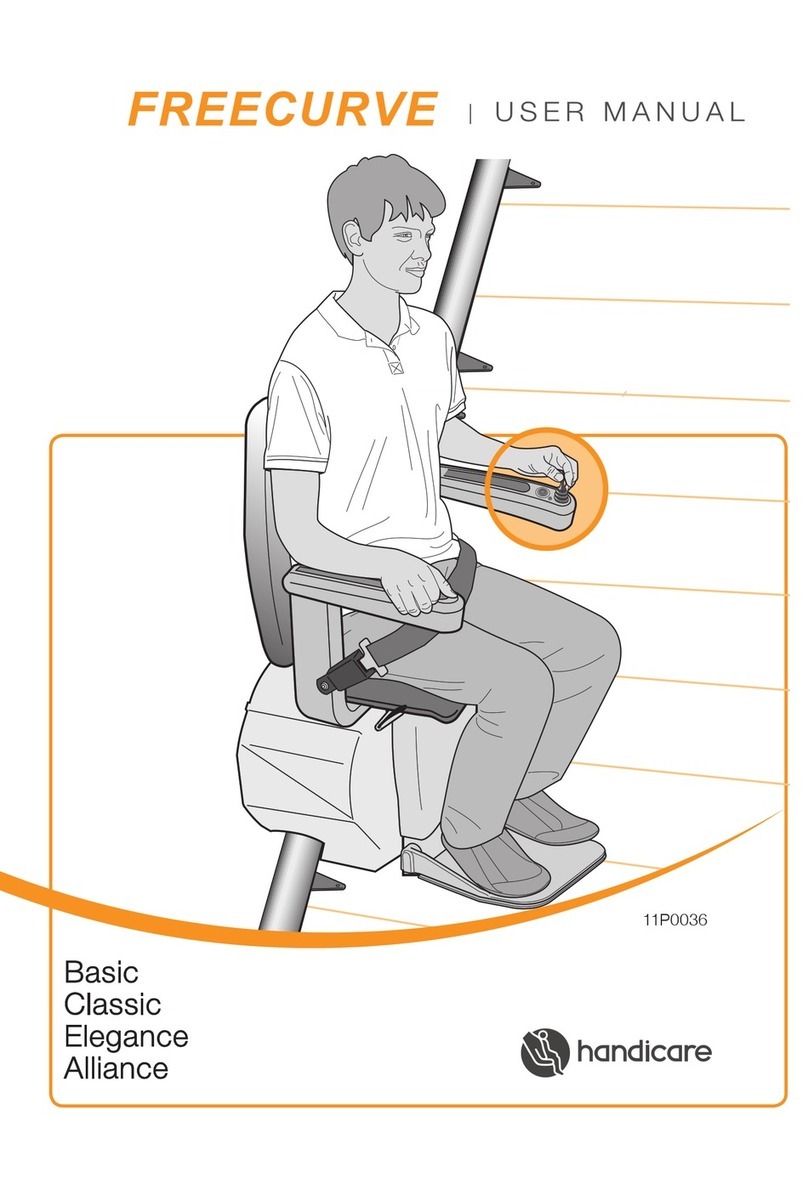
Handicare
Handicare FREECURVE Basic user manual

morse
morse 510-125 Operator's manual

Air Lift
Air Lift RideControl 59544 installation guide
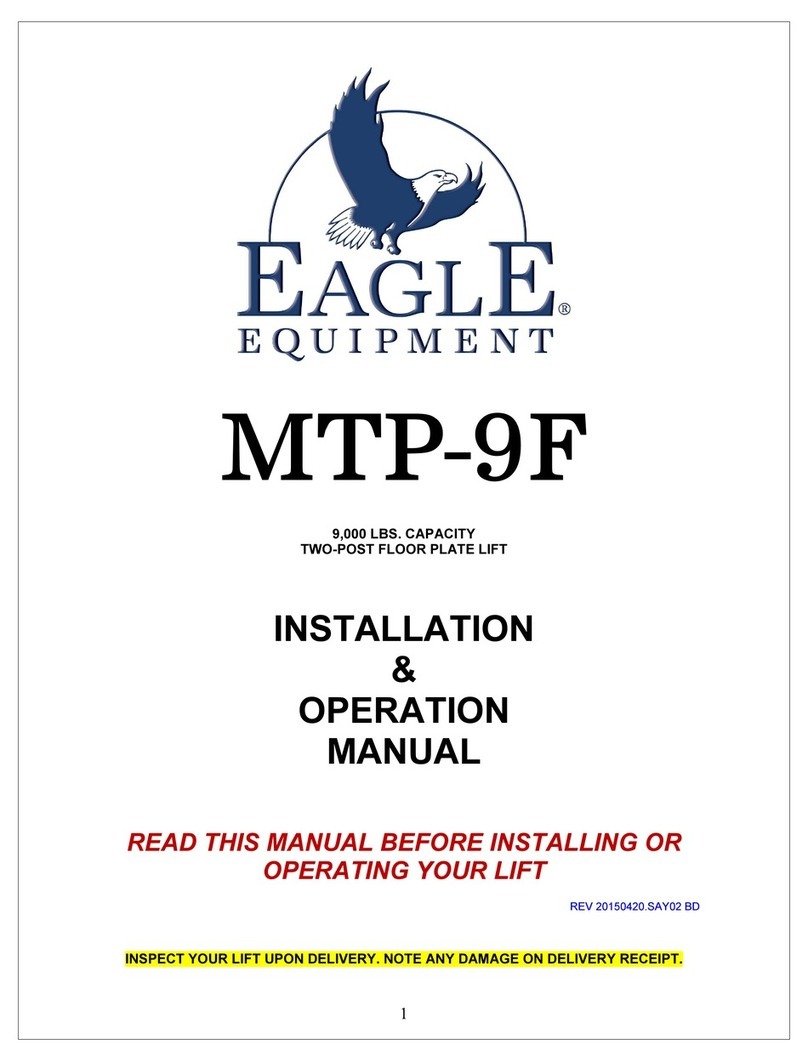
Eagle Equipment
Eagle Equipment MTP-9F Installation & operation manual
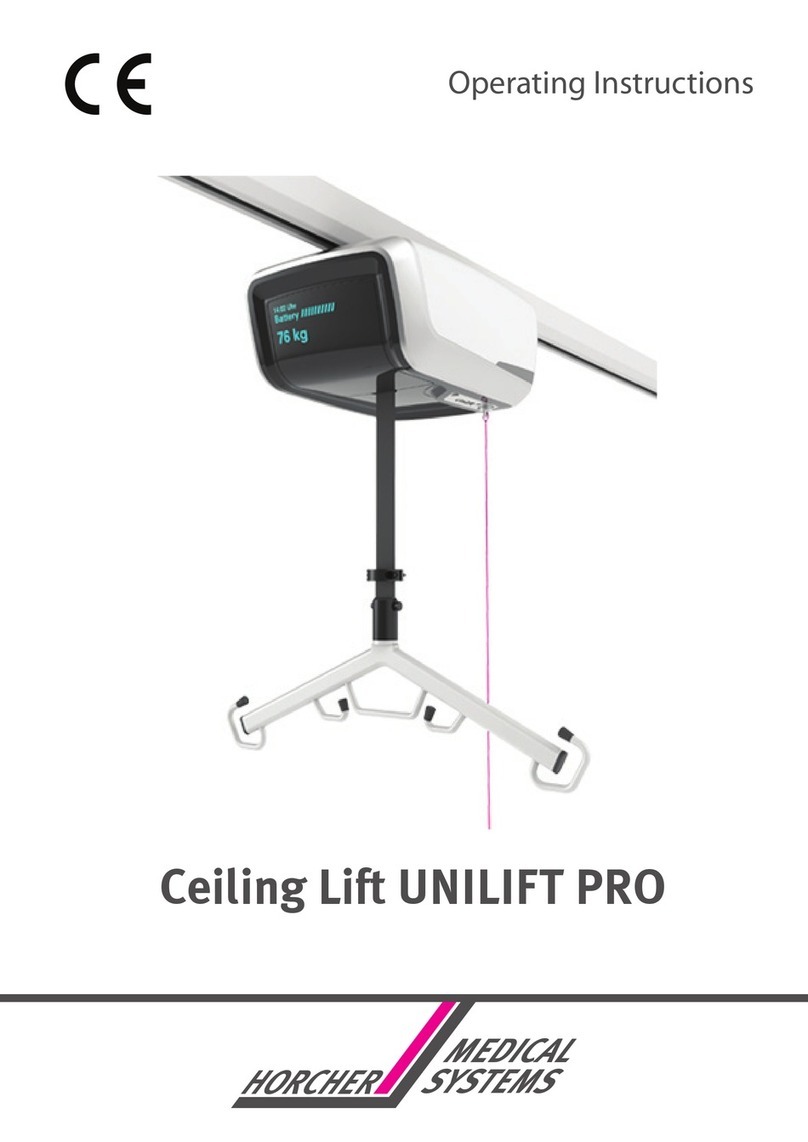
HORCHER
HORCHER UNILIFT PRO operating instructions

Mcombo
Mcombo 6360-SEC212W Operating instruction
